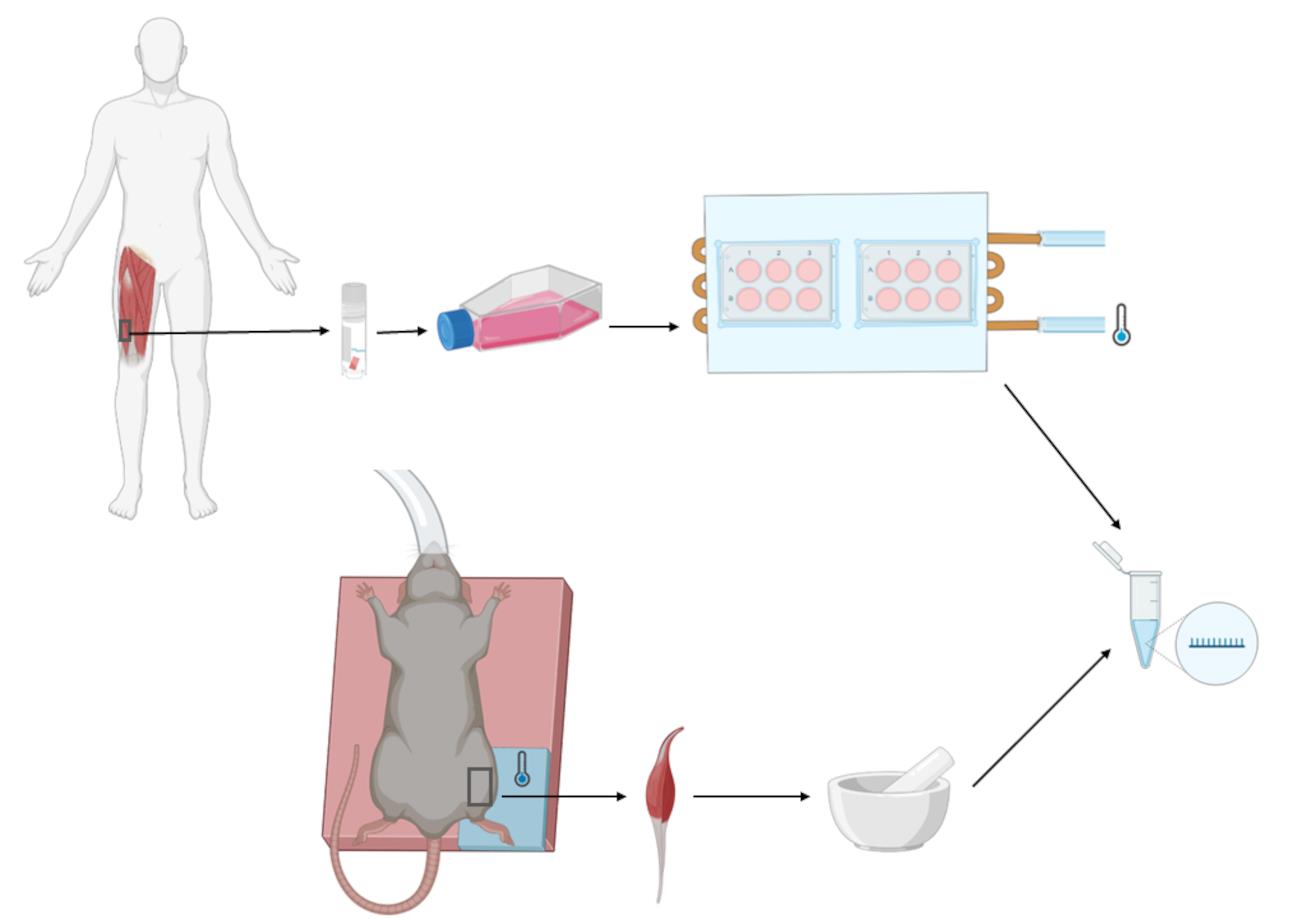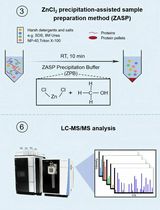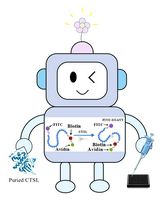- EN - English
- CN - 中文
Experimental Models for Cold Exposure of Muscle in vitro and in vivo
体外和体内肌肉低温暴露实验模型
(*contributed equally to this work) 发布: 2022年07月05日第12卷第13期 DOI: 10.21769/BioProtoc.4461 浏览次数: 2487
评审: Alessandro DidonnaAnonymous reviewer(s)
Abstract
Work in cold environments may have a significant impact on occupational health. In these and similar situations, cold exposure localized to the extremities may reduce the temperature of underlying tissues. To investigate the molecular effects of cold exposure in muscle, and since adequate methods were missing, we established two experimental cold exposure models: 1) In vitro exposure to cold (18°C) or control temperature (37°C) of cultured human skeletal muscle cells (myotubes); and 2) unilateral cold exposure of hind limb skeletal muscle in anesthetized rats (intramuscular temperature 18°C), with contralateral control (37°C). This methodology enables studies of muscle responses to local cold exposures at the level of gene expression, but also other molecular outcomes.
Graphical abstract:

Background
Occupational cold exposure is reported by 14% in surveys of Norwegian employees/workers (SSB LKU-A, 2019). Technically, cold working conditions are defined by ambient temperatures lower than +10°C (ISO15743:2008, 2008). The impact of a cold working environment at the level of workers’ tissues and cells is largely influenced by physical properties like air movement and humidity, but also behavioral factors like clothing and posture (Makinen and Hassi, 2009).
Exposure to cold temperatures has been associated with chronic pain in some studies (Vale et al., 2017; Farbu et al., 2019), while shorter durations of cold exposure may alleviate pain and inflammation (Bouzigon et al., 2016). Cold exposure localized to the extremities may reduce the temperature of underlying tissues (Saltin et al., 1968). The molecular changes and mechanisms occurring in muscle under cold conditions are currently unknown. To our knowledge, methods for cold exposure of cultured muscle cells and local cold exposure of muscles in anesthetized rats have not been established earlier, although it has been documented that cold exposure of short duration affects muscle gene expression (Egecioglu et al., 2018; Jaworska et al., 2018).
The current protocol may be used to elucidate the molecular effects of cold exposure in the short term. For example, gene expression in muscle, and muscle cell metabolism and secretion. The method could also be extended to study longer-lasting cold exposures, as well as other tissues and cell models.
Materials and Reagents
In vitro materials and reagents
Corning® CELLBIND® 6-well Plate (Corning Inc., catalog number: 734-1210)
Dulbecco’s Phosphate Buffered Saline (DPBS wo/Ca2+ and Mg2+) (Gibco®, Invitrogen, Gibco Life Technologies, catalog number: 14190169)
DMEM, low glucose, GlutaMAX (Gibco®, catalog number: 21885025)
Insulin, Actrapid penfil 100 IU (Novo Nordisk A/S, catalog number: 014398)
Fungizone® (250 µg/mL amphotericin B) (Gibco®, Invitrogen, Gibco Life Technologies, catalog number: 15290026)
Penicillin/Streptomycin (1,0000 U/mL, 10 mg/mL) (Gibco®, Invitrogen, Gibco Life Technologies, catalog number: 15140122)
Fetal bovine serum (FBS) (Gibco®, Invitrogen, Gibco Life Technologies, catalog number: 10500064)
HBSS wo/Ca2+ and Mg2+ (HycloneTM, GE Healthcare, catalog number: SH30588.01)
Trypanblue 0.4 % solution (Sigma-AldrichTM, catalog number: T10282)
Bovine serum albumin (BSA) (Sigma-AldrichTM, catalog number: A8412)
Dimethyl sulfoxide (DMSO) (Sigma-AldrichTM, catalog number: D2650)
Biopsies, musculus vastus lateralis, from four male donors (age 24–29)
Proliferation medium (see Recipes)
Differentiation medium (see Recipes)
In vivo materials and reagents
Female Lewis rats, 20 weeks old (150–200 g) (LEW/OrlRj, Janvier Labs, France)
Isoflurane (ESDG9623C, Baxter International Inc., US)
Ethanol (Kemetyl AS, catalog number: 600068)
Heparin 5000 IE/mL (LEO Pharma AS, catalog number: 009165-07)
MicroporeTM Surgical tape (3M Health Care, catalog number: 1535-1)
RNA-Solv® Reagent (Omega Bio-Tek, catalog number: R6830)
Equipment
In vitro equipment
CountessTM automated cell counter, counting chamber slides (Gibco®, InvitrogenTM, Gibco Life Technologies, catalog number: C10227/C10228)
Water bath (Hetofrig, catalog number: CB11)
CO2 Water-Jacketed incubator (Nuaire, model: NU-4500)
Microscope and cellSens Entry Software (Olympus, model: CKX41)
Cell scraper 24 cm (Sarstedt Inc., catalog number: 83.3951)
Thermal block: Aluminum block strung with perfusion tubes of copper, HI-CONTACTTM 6-PASS COLD PLATE (part No 416101u00000g, Aavid Thermoalloy SRL, Italy)
Stainless steel insulated flexible thermocouple temperature probe (Type-K 228-7445; RS Components AS, Norway)
USB TC-08 data logger (Pico Technology, catalog number: PP222) connected to a portable PC using the PicoLog software
Swip Shaker (Edmund Bühler GmbH, model: SM25-B)
In vivo equipment
Miniplus® 3 Peristaltic Pump (Gilson Inc., catalog number: GFAM00051)
Homeothermic blanket control unit (Harvard Apparatus Ltd., catalog number: 50-7137)
Rat Blanket Only, 15 × 20 cm (Harvard Apparatus Ltd., catalog number: 50-7214)
Harvard Apparatus Vaporizer (Baxter International Inc., catalog number: 34-0387)
Cooling plate EchoTherm (Torrey Pines, catalog number: IC25XR)
Surgical tools:
Spring scissors (Fine Science Tools, catalog number: 15000-08)
Fine scissors (Fine Science Tools, catalog number: 14058.09)
Forceps (Fine Science Tools, catalog number: 11252-00)
Forceps (Fine Science Tools, catalog number: 11006-12)
HaldenwangerTM Porcelain Spouted Mortar (Fisher Scientific, catalog number: 12373328)
Analysis equipment
2100 BioAnalyzer (Agilent Technologies, model: G2938C)
StepOnePlusTM Real-Time PCR Systems (Applied Biosystems, model: 4376592)
Mastercycler® nexus (Eppendorf® AG, model: 6333)
NanoDropTM 8000 Spectrophotometer (Thermo ScientificTM, model: ND-8000-GL)
Software
PicoLog software (PicoLog 6.2.4, Pico Technology, UK)
Procedure
文章信息
版权信息
© 2022 The Authors; exclusive licensee Bio-protocol LLC.
如何引用
Schjølberg, T., Asoawe, L., Krapf, S., Rustan, A. C., Thoresen, G. H. and Haugen, F. (2022). Experimental Models for Cold Exposure of Muscle in vitro and in vivo. Bio-protocol 12(13): e4461. DOI: 10.21769/BioProtoc.4461.
分类
细胞生物学 > 组织分析 > 损伤模型
分子生物学 > 蛋白质 > 表达
您对这篇实验方法有问题吗?
在此处发布您的问题,我们将邀请本文作者来回答。同时,我们会将您的问题发布到Bio-protocol Exchange,以便寻求社区成员的帮助。
提问指南
+ 问题描述
写下详细的问题描述,包括所有有助于他人回答您问题的信息(例如实验过程、条件和相关图像等)。
Share
Bluesky
X
Copy link












